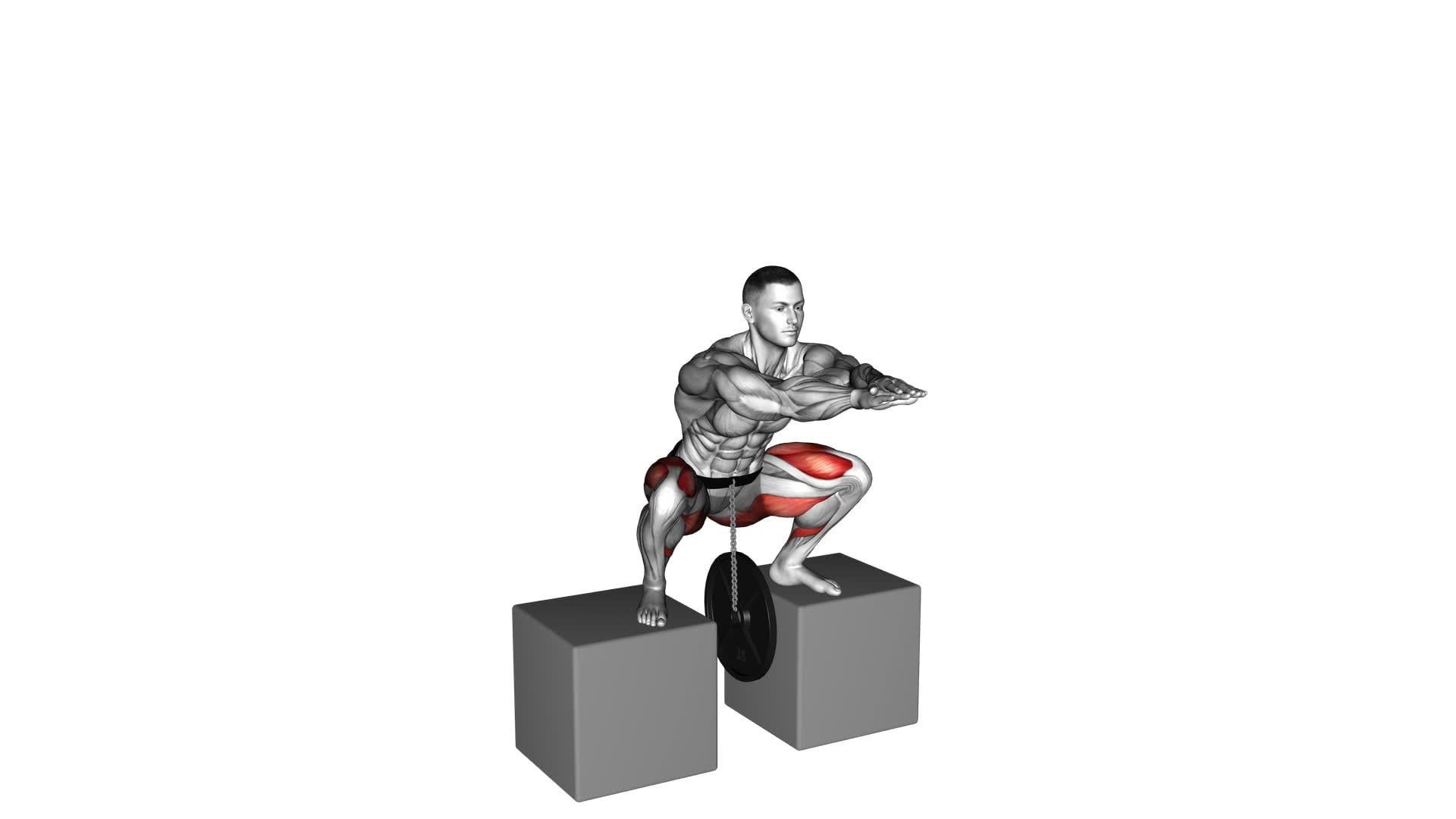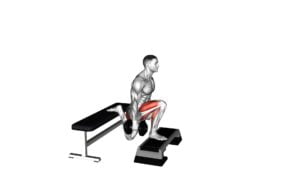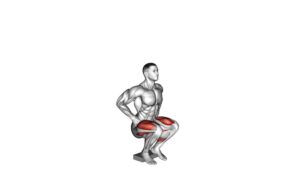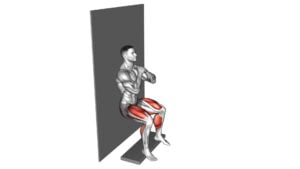Weighted Full Squat From Deficit (Male) – Video Exercise Guide & Tips

Are you looking to take your squat game to the next level?
Watch This Exercise Video
In this video exercise guide, we'll show you how to perform the weighted full squat from a deficit, targeting your lower body muscles for maximum gains.
With proper equipment and set-up, you'll learn the step-by-step technique, common mistakes to avoid, and tips to enhance your performance.
Get ready to increase the intensity and push your limits with this challenging exercise.
Let's dive in!
Key Takeaways
- Increased leg strength
- Improved muscular endurance
- Targets lower body muscles
- Builds stronger and more powerful leg muscles
Benefits of Weighted Full Squat From Deficit
You can experience increased leg strength and improved muscular endurance by incorporating weighted full squats from a deficit into your workout routine. This exercise specifically targets your lower body, helping you build stronger and more powerful leg muscles. By adding weight to your squats, you challenge your muscles to work harder, leading to increased strength gains. Additionally, performing squats from a deficit, where you stand on an elevated surface, enhances the range of motion and improves flexibility in your hips, knees, and ankles.
Weighted full squats from a deficit engage multiple muscle groups simultaneously, including your quadriceps, hamstrings, glutes, and calves. This compound movement not only builds strength but also improves overall lower body stability. Incorporating this exercise into your routine can also benefit your athletic performance, as it mimics functional movements used in sports and daily activities.
To perform weighted full squats from a deficit, start by standing on an elevated platform with your feet shoulder-width apart. Hold a barbell across your upper back, ensuring your core is engaged and your spine is neutral. Bend your knees and lower your body until your thighs are parallel to the ground, then push through your heels to return to the starting position. Remember to maintain proper form throughout the exercise, keeping your chest up and your knees tracking over your toes.
Proper Equipment and Set-Up
To ensure proper execution and maximize the benefits of weighted full squats from a deficit, it's essential to have the appropriate equipment and set-up. Equipment selection plays a crucial role in maintaining stability and safety during this exercise. Start by choosing a sturdy barbell that can handle the desired weight. Opt for a squat rack or power rack with adjustable safety pins to provide support and prevent injuries. Additionally, make sure to use weight plates that are suitable for your fitness level and goals.
Proper warm-up is equally important before performing weighted full squats from a deficit. Begin with a dynamic warm-up routine that includes exercises like leg swings, hip rotations, and bodyweight squats. This helps increase blood flow to the muscles and prepares them for the intense workout ahead. It's advisable to perform a few sets of bodyweight squats or goblet squats to further activate the lower body muscles.
When setting up for the exercise, position yourself on a stable platform with a deficit height that allows for proper range of motion. Place the barbell across your upper back, resting it on your trapezius muscles. Keep your feet shoulder-width apart and toes slightly pointed outward. Maintain a neutral spine throughout the movement and engage your core for stability.
Step-by-Step Guide to Perform the Exercise
Start by positioning yourself on a stable platform with a deficit height that allows for proper range of motion during the weighted full squat from a deficit exercise. Place a barbell on your upper back, just below your neck, and grip it with your hands slightly wider than shoulder-width apart.
Stand with your feet shoulder-width apart, toes slightly turned out. Take a deep breath and brace your core. Lower your body by bending at the hips and knees, keeping your chest up and your back straight. Squat down until your thighs are parallel to the ground or lower, ensuring that your knees track over your toes.
Push through your heels and extend your hips and knees to return to the starting position. This exercise primarily targets your quadriceps, hamstrings, glutes, and lower back muscles. Remember to maintain proper form throughout the entire movement and avoid rounding your back or letting your knees cave in.
Transitioning into the next section, let's now discuss common mistakes to avoid during the weighted full squat from a deficit exercise.
Common Mistakes to Avoid
When performing weighted full squats from a deficit, it's crucial to maintain proper form to avoid injury and maximize results.
Be sure to avoid using excessive weight, as this can compromise your form and increase the risk of strain or injury.
Additionally, focus on maintaining balance and stability throughout the exercise to ensure proper engagement of the targeted muscles and prevent any unnecessary strain on other areas of the body.
Proper Form Importance
You should prioritize proper form when performing weighted full squats from a deficit to avoid common mistakes. The importance of technique can't be overstated in this exercise.
Maintaining proper form not only helps prevent injuries but also ensures that you're effectively targeting the muscles involved. One common form error to avoid is rounding your lower back during the squat. This can lead to lower back strain and diminish the effectiveness of the exercise.
Another mistake is allowing your knees to cave inwards as you squat down. This puts excessive stress on the knee joint and can lead to injury.
Lastly, make sure to keep your weight balanced evenly on your feet throughout the movement, avoiding leaning too far forward or backward.
Prioritizing proper form will help you get the most out of your weighted full squats from a deficit.
Avoiding Excessive Weight
To avoid common mistakes and potential injuries, it's crucial to avoid using excessive weight when performing weighted full squats from a deficit. By following proper weightlifting techniques and focusing on injury prevention, you can optimize your squatting form and minimize the risk of harm.
Here are five key points to keep in mind:
- Gradually increase the weight: Start with a manageable weight and gradually progress over time to challenge your muscles without overloading them.
- Maintain proper form: Focus on keeping your back straight, chest up, and knees aligned with your toes throughout the movement.
- Listen to your body: Pay attention to any pain or discomfort and adjust the weight accordingly to avoid straining your muscles or joints.
- Use a spotter or safety equipment: If you're lifting heavy weights, have a spotter nearby or use safety equipment like squat racks to ensure your safety.
- Prioritize technique over weight: Always prioritize proper form and technique rather than lifting heavier weights. It's better to perform the exercise correctly with lighter weights than to risk injury with excessive weight.
Balance and Stability
To maintain balance and stability during weighted full squats from a deficit, it's important to focus on maintaining proper form and engaging your core muscles. Improving stability starts with maintaining a neutral spine throughout the movement. Avoid rounding or arching your back, as this can lead to loss of balance and potential injury.
Engaging your core muscles, specifically your transverse abdominis, will help stabilize your trunk and maintain proper alignment. Additionally, keeping your feet shoulder-width apart and distributing your weight evenly between your heels and the balls of your feet will enhance stability.
Tips to Enhance Your Performance
Improve your performance by incorporating weighted full squats from a deficit into your training routine. This exercise is highly effective for enhancing strength and improving technique. Here are five tips to help you maximize your performance:
- Maintain proper form: Keep your feet shoulder-width apart, chest up, and back straight throughout the movement. This will ensure that you engage the correct muscles and prevent injuries.
- Start with lighter weights: Begin with a weight that allows you to perform the exercise with proper form. Gradually increase the weight as you become more comfortable and confident in your technique.
- Focus on depth: Aim to squat below parallel, as this will engage your muscles more effectively and increase the overall effectiveness of the exercise.
- Control the descent and ascent: Lower yourself in a controlled manner, avoiding any sudden movements or bouncing at the bottom. Similarly, rise up in a controlled manner without locking your knees at the top.
- Incorporate progressive overload: Continuously challenge yourself by gradually increasing the weight or reps over time. This will help stimulate muscle growth and improve your overall strength.
How to Progress and Increase the Intensity
To progress and increase the intensity of your weighted full squat from deficit, there are a few key points to keep in mind.
First, gradually add weight to your squat in small increments, ensuring that you maintain proper form and technique.
Secondly, vary your rep ranges to challenge your muscles in different ways and promote further strength gains.
Lastly, consider incorporating advanced techniques like drop sets, supersets, or pause reps to further push your limits and continue making progress.
Adding Weight Gradually
Start by gradually increasing the weight used during your weighted full squat from deficit exercise. This gradual progression is crucial for effectively increasing resistance and challenging your muscles to grow stronger. Here are some tips to help you add weight gradually and safely:
- Begin with a weight that allows you to complete the desired number of reps with proper form.
- Increase the weight by small increments, such as 2.5 to 5 pounds, every week or every other week.
- Focus on maintaining proper technique and range of motion as you add weight.
- Listen to your body and make adjustments based on your strength and comfort level.
- Aim to increase the weight gradually over time to avoid sudden jumps that may lead to injury.
By gradually increasing the weight, you'll be able to steadily progress and continue challenging your muscles.
This sets the stage for the next section, where we'll discuss the importance of varying rep ranges.
Varying Rep Ranges
To effectively progress and increase the intensity of your weighted full squat from deficit exercise, you can vary the rep ranges. Varying the rep ranges allows you to challenge your muscles in different ways and prevent plateaus.
One way to do this is by increasing the weight you use for each set. As you become stronger, you can gradually add more weight to continue challenging your muscles and stimulating growth.
Another advanced modification you can make to vary the rep ranges is to incorporate drop sets. This involves performing a set with a heavy weight until failure, then immediately reducing the weight and performing another set until failure. This technique helps to exhaust your muscles and push them to their limits, promoting muscle growth and strength gains.
Experiment with different rep ranges and modifications to find what works best for you and your fitness goals.
Incorporating Advanced Techniques
As you continue to challenge your muscles and prevent plateaus, incorporate advanced techniques to progress and increase the intensity of your weighted full squat from deficit exercise. These techniques will push your limits and help you achieve greater strength gains and muscle development.
Here are five advanced techniques to consider:
- Tempo Training: Control the speed of your squat, emphasizing the eccentric (lowering) and concentric (rising) phases to increase time under tension.
- Cluster Sets: Perform multiple sets with short rest intervals between reps to maintain intensity and stimulate muscle growth.
- Drop Sets: Start with a heavy weight and gradually decrease the load as you reach muscle failure, pushing your muscles to their limits.
- Paused Reps: Pause at the bottom of the squat for a few seconds to challenge your muscles and improve explosiveness.
- Overload Training: Incorporate resistance bands or chains to add extra resistance at the top of the movement, increasing difficulty.
Frequently Asked Questions
How Often Should I Perform the Weighted Full Squat From Deficit Exercise?
To get the most out of the weighted full squat from deficit exercise, it's important to find the right balance.
You should aim to perform this exercise 2-3 times a week, with at least one day of rest in between. This frequency allows your muscles to recover and grow stronger.
Can I Substitute the Deficit With a Different Variation of the Squat Exercise?
Yes, you can substitute the deficit with a different variation of the squat exercise. However, it's important to note that the deficit squat offers unique benefits.
By elevating your heels on a platform, it increases the range of motion and targets your quads, glutes, and hamstrings more effectively.
Other variations may not provide the same benefits, so consider incorporating deficit squats into your routine for maximum results.
Are There Any Specific Warm-Up Exercises I Should Do Before Attempting the Weighted Full Squat From Deficit?
Before attempting the weighted full squat from deficit, it's crucial to perform specific warm-up exercises to prepare your body for the movement. These exercises can include dynamic stretches, mobility drills, and light sets of squats.
Warm-up exercises help increase blood flow, improve flexibility, and activate the muscles involved in the squat. Additionally, focusing on proper form during warm-up sets is essential to ensure a safe and effective workout.
Can I Still Perform This Exercise if I Have Knee or Hip Issues?
If you have knee or hip issues, there are alternative exercises you can do instead of the weighted full squat from deficit. These exercises can help you work your lower body without putting excess strain on your knees or hips.
Additionally, if you're a beginner with knee or hip issues, there are modifications you can make to the weighted full squat from deficit to make it more manageable for you.
It's important to prioritize your safety and comfort when choosing exercises.
Should I Use a Belt or Lifting Shoes While Performing the Weighted Full Squat From Deficit?
When performing the weighted full squat from a deficit, you may wonder whether to use a belt or lifting shoes. Both options have their benefits.
Using a belt can provide extra support to your core, helping you maintain proper form and prevent injury.
Lifting shoes, on the other hand, offer stability and better ankle mobility, allowing you to perform the exercise with better technique.
Consider your personal preference and comfort level to decide whether to go belt vs. barefoot.
Conclusion
In conclusion, performing weighted full squats from a deficit offers several benefits.
These benefits include increased lower body strength and improved stability.
To ensure safety and effectiveness, it's important to use proper equipment and set up the exercise correctly.
By following the step-by-step guide and avoiding common mistakes, you can enhance your performance.
To progress and increase intensity, gradually increase the weight and decrease the deficit height.

Author
Years ago, the spark of my life’s passion ignited in my mind the moment I stepped into the local gym for the first time. The inaugural bead of perspiration, the initial endeavor, the very first surge of endorphins, and a sense of pride that washed over me post-workout marked the beginning of my deep-seated interest in strength sports, fitness, and sports nutrition. This very curiosity blossomed rapidly into a profound fascination, propelling me to earn a Master’s degree in Physical Education from the Academy of Physical Education in Krakow, followed by a Sports Manager diploma from the Jagiellonian University. My journey of growth led me to gain more specialized qualifications, such as being a certified personal trainer with a focus on sports dietetics, a lifeguard, and an instructor for wellness and corrective gymnastics. Theoretical knowledge paired seamlessly with practical experience, reinforcing my belief that the transformation of individuals under my guidance was also a reflection of my personal growth. This belief holds true even today. Each day, I strive to push the boundaries and explore new realms. These realms gently elevate me to greater heights. The unique combination of passion for my field and the continuous quest for growth fuels my drive to break new ground.







